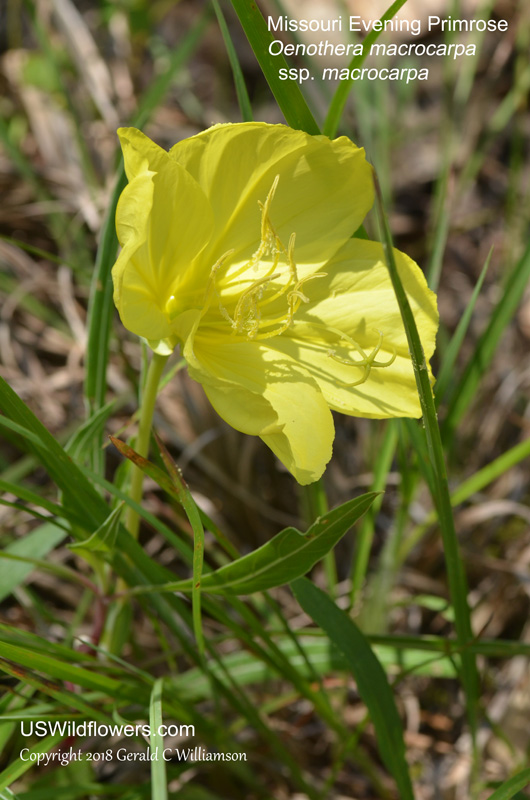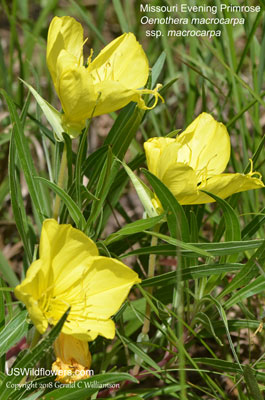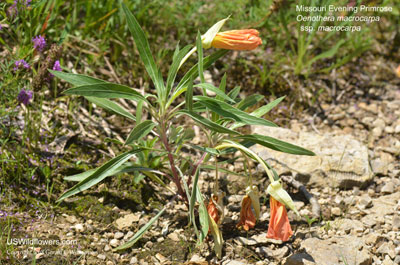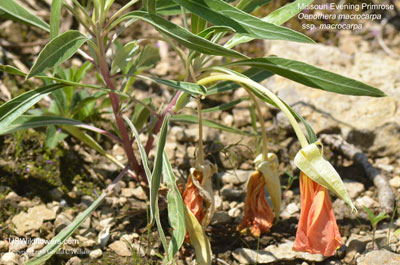Missouri Evening Primrose, Ozark Sundrop, Bigfruit Evening Primrose, Wingfruit Evening-Primrose - Oenothera macrocarpa ssp macrocarpa
|
Oenothera macrocarpa ssp macrocarpa - Missouri Evening Primrose, Ozark Sundrop, Bigfruit Evening Primrose, Wingfruit Evening-Primrose.
Oenothera is a large genus of about 145 species as now classified, with Evening Primroses found in temperate to subtropical areas of North, Central, and South America. The area with most species is the southwest of the United States, and there are Oenothera species in every state except for Alaska (also in all of Canada except Yukon). The genus is somewhat in flux, with several genera of Onagraceae, such as Gaura having been moved into Oenothera based on studies published early in the 21st century.
Oenothera macrocarpa is a species of mid-America, found in rocky sites like bluffs, rocky prairies, and glades from Nebraska south to Texas and east to the Mississippi River. It is also found in a county or so each in Illinois, Tennessee, and Wyoming, states where it is considered rare, and is legally protected in Tennessee. There are 4 or 5 recognized subspecies: - ssp. incana
- ssp. fremontii
- ssp. macrocarpa (the species presented here)
- ssp. mexicana (1st reported in 1994; verified 1999)
- ssp. oklahomensis.
Between the subspecies are differences in leaf shape and margin, growth habit, hairiness, and other small morphological attributes.
Synonym: Oenothera missouriensis
Found in:
AR, IL, KS, MO, NE, OK, TN, TX, WY | 
Distribution of Oenothera macrocarpa ssp macrocarpa in the United States and Canada:

Map courtesy of The Biota of North America Program.
Map color key
Search Our Database: Enter any portion of the Scientific, Common Name, or both.
Do a general Google search of the entire site:
#ad
 Follow USWildflowers on Twitter
| | Site: Flat Rock Cedar Glades and Barrens State Natural Area, Rutherford County, TN Date: 2018-June-05 | Photographer: Gerald C. Williamson
Nikon D7000
Tamron SP 90MM f/2.8 AF Macro | | The large, showy flower of Missouri Evening Primrose has 4 bright yellow petals, with 8 yellow stamens and a yellow pistil. The flower is up to 3 or 4 inches across. | | 
| | Site: Flat Rock Cedar Glades and Barrens State Natural Area, Rutherford County, TN Date: 2018-June-05 | Photographer: Gerald C Williamson
Nikon D7000 | | The crossed stigma - signature of most Oenothera species - is on a style of up to 6 inches long may be exserted beyond the large petals. The flower has 4 greenish-yellow sepals - descriptions say they frequently have reddish purple splotches and a reddish purple stripe along the margin, but I did not observe that in the plants at this Tennessee location. The flower is held on what I would have described as a long pedicel, but it is actually part of the hypanthium, a floral tube (aka calyx tube) of up to 4 or 5 inches long. If you follow the floral tube (which has glandular pubescence) of the rightmost flower down to near the bottom of the photo, you can see the whitish ovary, and below that the short pedicel. | | Click on the photo for a larger image

| | Site: Flat Rock Cedar Glades and Barrens State Natural Area, Rutherford County, TN Date: 2018-June-05 | Photographer: Gerald C Williamson | | Oenothera macrocarpa ssp. macrocarpa can grow up to about 18 or 20 inches tall, and may have some shorter side branches from the purplish stem. The leaves are usually elliptic (or similarly shaped), much longer than wide, frequently almost linear. There are frequently fascicles. The flowers may fade to orange, as in this photo. | | Click on the photo for a larger image

| | Site: Flat Rock Cedar Glades and Barrens State Natural Area, Rutherford County, TN Date: 2018-June-05 | Photographer: Gerald C Williamson | | The leaves of Missouri Evening Primrose are usually moderately hairy, especially on younger leaves. In this photo you can see the developing winged fruit at the base of the leftmost flower. | | Click on the photo for a larger image

|
References used for identification and information:
|
|
| |
| #ad
|
|






